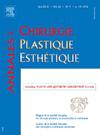Anatomie de la région frontale
IF 0.5
4区 医学
Q4 SURGERY
引用次数: 0
Abstract
La région frontale est une région anatomique limitée en haut par la ligne d’implantation des cheveux, en bas par les sourcils et la glabelle et latéralement par le bord antérieur des fosses temporales. Sa situation verticale, due à la croissance du télencéphale, est caractéristique de l’espèce humaine. De la superficie à la profondeur, il est décrit dans cet article d’abord la peau et les tissus sous-cutanés qui présentent des compartiments adipeux. Le plan musculaire est représenté surtout par les muscles frontaux élévateurs de la peau du front et des sourcils et les muscles abaisseurs de la peau du front et du sourcils qui sont de la superficie à la profondeur les muscles procerus et orbiculaires de l’œil, puis le muscle abaisseur du sourcil, puis le muscle corrugateur du sourcil. La galea aponévrotique située sous les muscles frontaux est une lame fibreuse qui reçoit à sa périphérie les insertions musculaires des muscles du crâne. Le périoste est adhérent à l’os frontal qui présente un dimorphisme sexuel. Chez l’homme, le front est plat avec des rebords orbitaires supérieurs accentués alors que chez la femme le front est galbé et l’os frontal ne présente pratiquement pas de rebords orbitaires supérieurs. La vascularisation est formée par un pédicule antérieur constitué essentiellement par les artères supra-orbitaires et supra-trochléaires, qui sont des branches de l’artère ophtalmique, et leurs veines satellites et un pédicule latéral formé par les branches antérieures de l’artère et de la veine temporale superficielle. L’innervation sensitive provient du nerf ophtalmique (de Whillis) qui donne le nerf frontal, le nerf naso-ciliaire et le nerf lacrymal. L’innervation motrice est assurée par le rameau temporal du nerf facial qui après être passé latéralement par rapport à l’arcade zygomatique chemine dans l’espace épicrânien et innerve le muscle frontal et les muscles corrugator et procerus.
The forehead is an anatomic region located between the frontal hairline cranially, the eyebrow and the glabella caudally, and the anterior border of the temporal fossa laterally on both sides. Its vertical situation, due to the telencephalon growth, is specific of the human species. From surface to deep planes, the skin and sub-cutaneous fat pads are described first. The muscular plane is constituted of the frontal muscles elevators of the forehead and the eyebrow, and the depressors which are the procerus and orbicularis oculi muscles superficially, the depressor supercilii muscle, and the corrugator supercilii in a deep plane. The galea aponeurotica, located deep to the frontal muscles, is a fibrous lamina on which the muscles of the skull insert. There is a sexual dimorphism of the frontal bone. The male forehead has extensive supraorbital bossing, and above this there is often a flat area, in teh femalethe supraorbital bossing is often nonexistent and above, there is a continous mild curvature. Blood supply to the forehead is given by an anterior pedicle constituted by the supraorbital and supratrochlear vessels and a lateral pedicle made of the anterior branches from the superficial temporal vessels. The sensory innervation of the forehead is given by the ophtalmic nerve which divides in frontal, nasociliar and lacrymal nerves. The motor innervation is given by the temporal ramus of the facial nerve which passes laterally to the zygomatic arch, and gives the innervation of the frontal, corrugator supercilii and procerus muscles.
[额部解剖学]。
前额是一个解剖区域,位于头顶的额发际线、尾部的眉毛和睑板以及两侧颞窝前缘之间。由于端脑的生长,它的垂直位置是人类特有的。从表面到深层,首先描述的是皮肤和皮下脂肪垫。肌肉平面由额头和眉毛的额肌提升器、眼轮匝肌和眼轮匝肌下压器构成,眼轮匝肌下压器和眼轮匝肌下压器在深层平面上由额头和眉毛的额肌提升器、眼轮匝肌下压器构成。位于额肌深部的颅骨肌腱膜(galea aponeurotica)是一个纤维薄片,头骨的肌肉都插在上面。额骨存在性别二形性。男性的前额有广泛的眶上凸起,在其上方通常有一个平坦的区域,女性的眶上凸起通常不存在,在其上方有一个持续的轻度弯曲。前额的血液供应由眶上血管和颞上血管构成的前支和颞浅血管前支构成的侧支提供。前额的感觉神经由眼球神经提供,眼球神经分为额神经、鼻孔神经和泪腺神经。运动神经支配由面神经的颞横突提供,该神经穿过侧面到达颧弓,并支配额肌、皱眉上肌和前额肌。
本文章由计算机程序翻译,如有差异,请以英文原文为准。
求助全文
约1分钟内获得全文
求助全文
来源期刊
CiteScore
1.00
自引率
0.00%
发文量
86
审稿时长
44 days
期刊介绍:
Qu''elle soit réparatrice après un traumatisme, pratiquée à la suite d''une malformation ou motivée par la gêne psychologique dans la vie du patient, la chirurgie plastique et esthétique touche toutes les parties du corps humain et concerne une large communauté de chirurgiens spécialisés.
Organe de la Société française de chirurgie plastique reconstructrice et esthétique, la revue publie 6 fois par an des éditoriaux, des mémoires originaux, des notes techniques, des faits cliniques, des actualités chirurgicales, des revues générales, des notes brèves, des lettres à la rédaction.
Sont également présentés des analyses d''articles et d''ouvrages, des comptes rendus de colloques, des informations professionnelles et un agenda des manifestations de la spécialité.

 求助内容:
求助内容: 应助结果提醒方式:
应助结果提醒方式:


